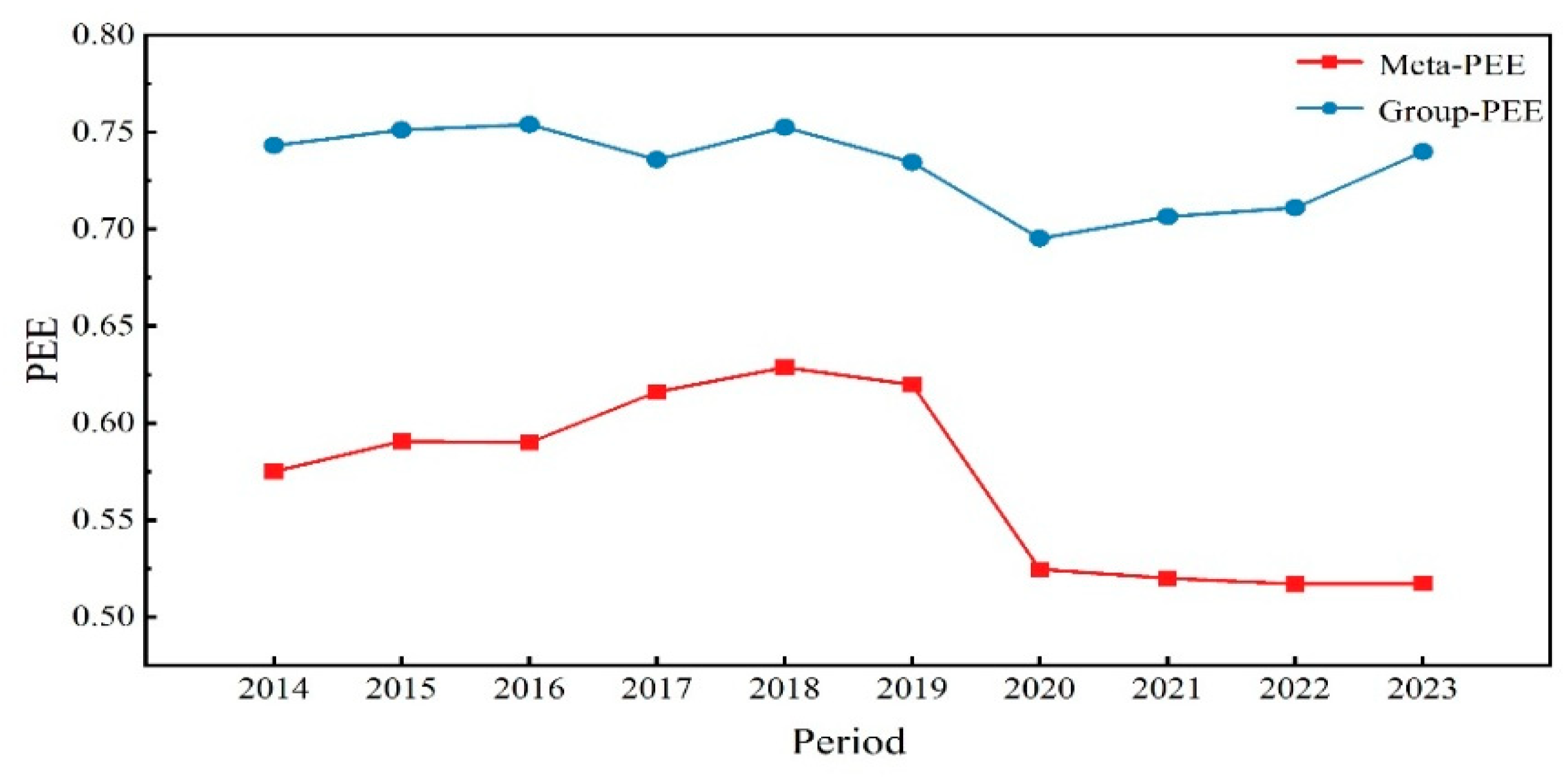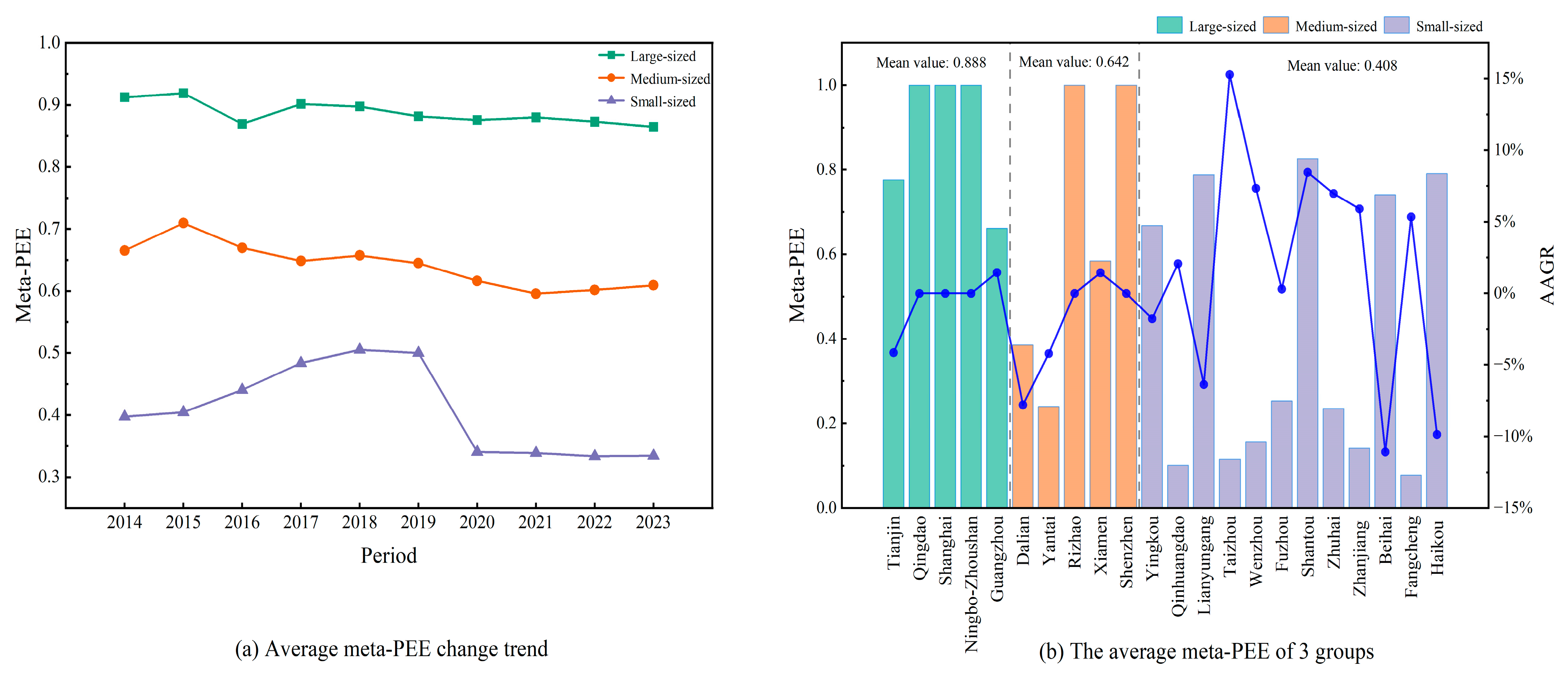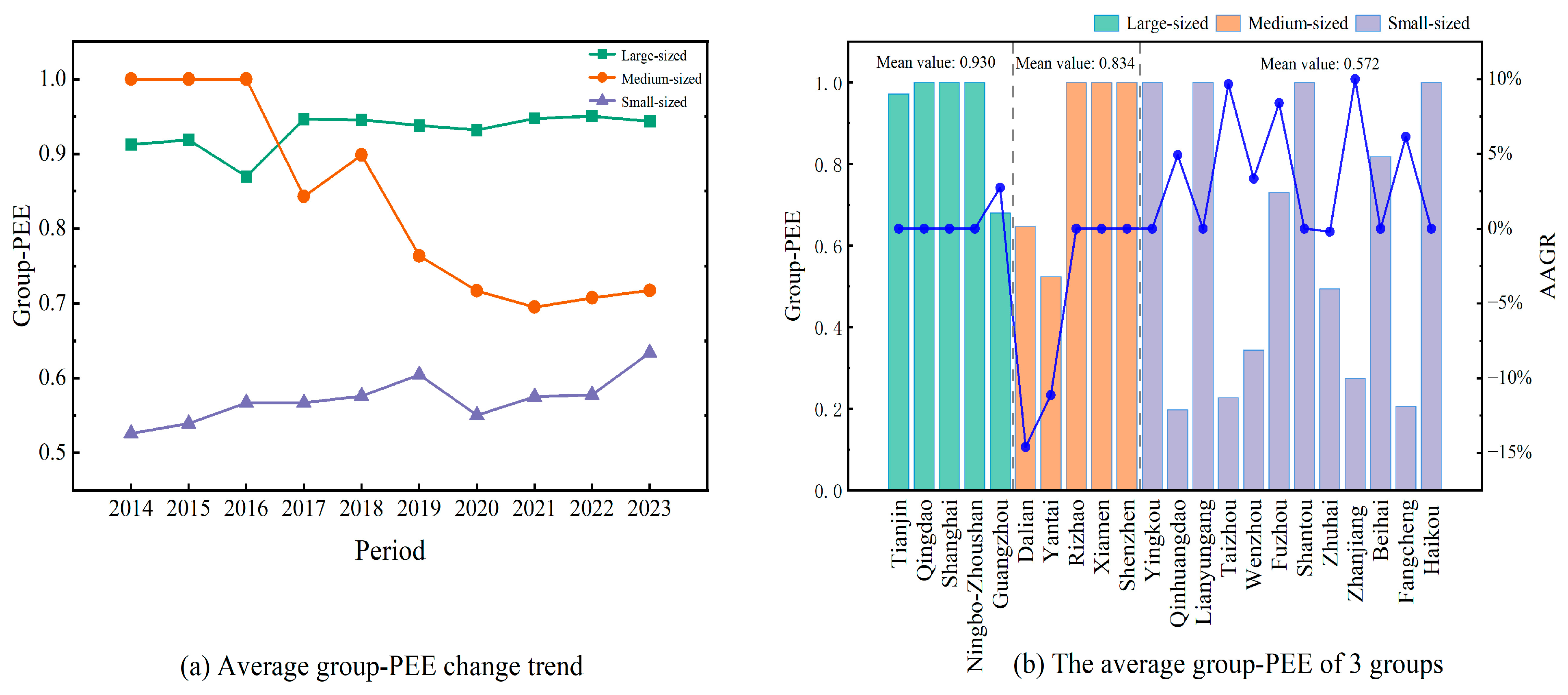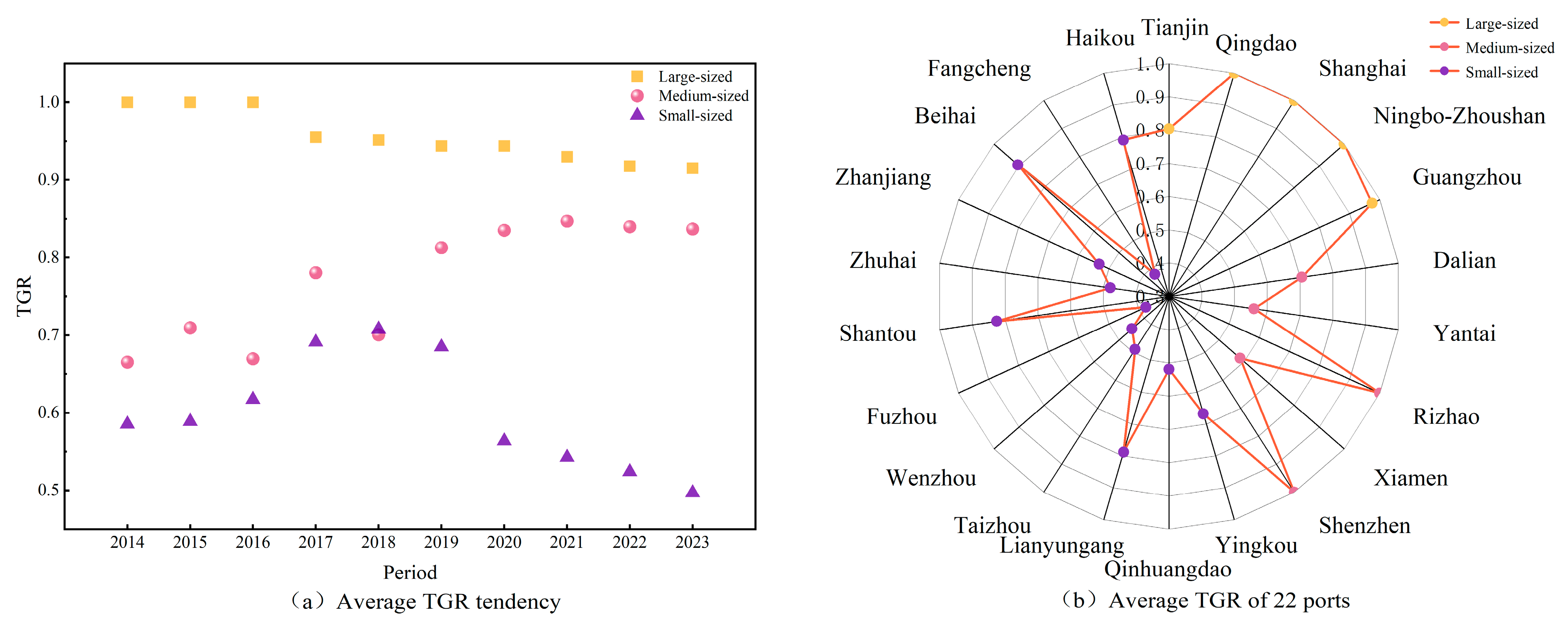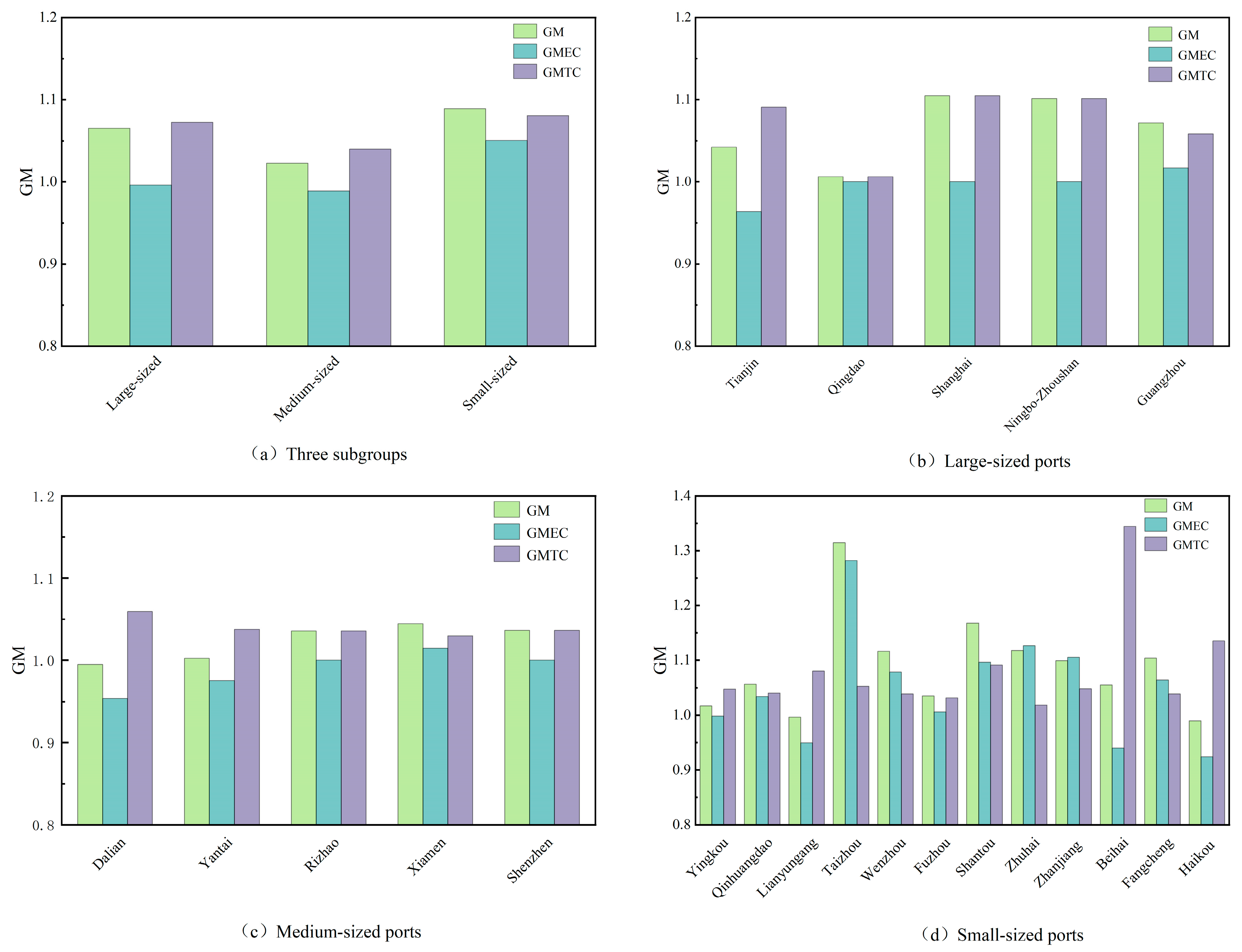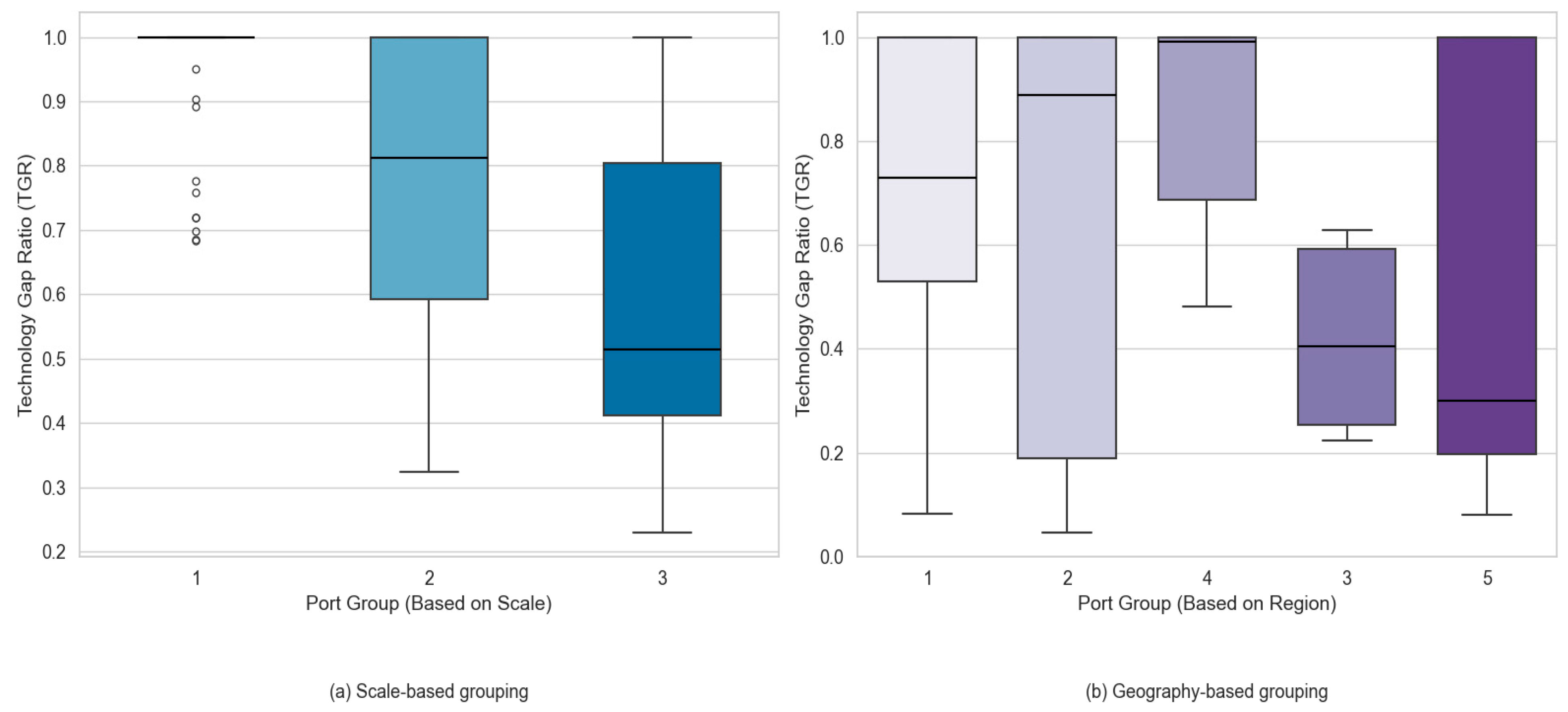4.1. Overall Analysis of Port Environmental Efficiency
The meta-PEE and group-PEE trends are illustrated in
Figure 2. From the meta-frontier perspective, the meta-PEE experienced a fluctuating downward trend over the period 2014–2023, with an average annual decline of approximately 1.173%. Between 2014 and 2018, the mean meta-PEE increased somewhat, from 0.575 to 0.629, representing a 9.391% improvement overall. This growth may primarily be attributed to concerted efforts promoting smart ports, enhancing port integration, and prioritizing sustainable development [
47,
48]. However, this positive momentum did not persist. From 2018 to 2022, a substantial decline in efficiency was detected. The average meta-PEE fell sharply to 0.517, representing a reduction of 17.806%. This deterioration was largely induced by the COVID-19 pandemic, which caused a significant drop in cargo throughput and disrupted normal port operations [
49].
With respect to the group frontier, a similar “rise-then-fall” pattern was observed in group-PEE, with its overall trajectory broadly consistent with that of the meta-PEE. Notably, the mean group-PEE (0.732) was significantly higher than that of meta-PEE (0.570), which is in line with Li et al. [
27]. This divergence underscores the importance of accounting for technological heterogeneity across ports. When such heterogeneity is considered, PEE estimates become more representative of actual performance.
As depicted by
Figure 3a, substantial disparities in meta-PEE were observed among ports of different sizes during 2014–2023. The average meta-PEEs for large-sized, medium-sized, and small-sized ports were 0.888, 0.642, and 0.408, respectively, while the national average stood at 0.570. The findings highlight pronounced variations in environmental performance across port size categories, suggesting that larger ports possess a distinct advantage in terms of carbon mitigation performance. This discrepancy may be attributed to several factors. Large-sized ports often enjoy better access to capital, advanced technologies, and policy support, enabling more efficient implementation of green practices. They are also vulnerable to greater regulatory pressure, which can hasten environmental improvements. In contrast, small-sized and medium-sized ports may encounter financial and technical constraints, limiting their ability to invest in low-carbon infrastructure and decarbonization technologies.
The meta-PEE values for individual ports are presented in
Figure 3b. Among the 22 coastal ports evaluated, only 5 ports were positioned on the meta-frontier, representing approximately 23% of the sample. Specifically, the ports of Shanghai, Ningbo-Zhoushan, and Qingdao were classified as large-sized ports, while Shenzhen Port and Rizhao Port were medium-sized. These ports demonstrated a strong capacity to enhance operational performance while effectively mitigating carbon emissions. Notably, several small-sized ports also exhibited notable environmental performance. Ports such as Yingkou, Lianyungang, Shantou, Beihai, and Haikou performed relatively well in decarbonization, suggesting that, despite limited scale and constrained resources, effective emission control can still be achieved. In contrast, poor performance was observed in certain middle-sized ports, particularly the ports of Yantai, Xiamen, and Dalian. Although these ports possess considerable operational capacity, their PEE was hindered by suboptimal resource allocation and possibly inefficient management pattens.
Notably, nearly half of the small-sized ports recorded an average annual growth rate (AAGR) in meta-PEE exceeding 5%, manifesting considerable potential for further decarbonization. In contrast, medium-sized ports have generally suffered increasing pressure from diminishing meta-PEE, with some exhibiting a persistent trend of deterioration.
From the group frontier perspective, the average group-PEE during 2014–2023 was 0.930 for large-sized ports, 0.834 for medium-sized ports, and 0.572 for small-sized ports, with a national average of 0.732. Compared with the corresponding meta-PEE values, all three subgroups experienced varying degrees of improvement, approximately 4.730%, 29.907%, and 40.196%, separately. These results suggest that when technological heterogeneity across port groups is disregarded, PEE tends to be underestimated. The significance of incorporating group-specific technical heterogeneity into the evaluation of port carbon mitigation performance is thus underscored. In terms of temporal trends (see
Figure 4a), the group-PEE for large-sized ports remained relatively stable, with only a slight decline observed in 2016. Medium-sized ports initially performed well, even surpassing large-sized ports temporarily. However, a sharp decline was observed from 2016 onwards, eventually stabilizing around 0.7 in later years, showcasing a volatile downward trajectory. In contrast, small-sized ports exhibited a steady upward trend in group-PEE, suggesting continuous progress in decarbonization efforts over time.
As illustrated in
Figure 4b, ten ports were identified as DEA-efficient under their respective group frontiers, representing approximately 45% of the total sample. Besides the aforementioned five ports that reached the meta-frontier, the remaining five ports include Xiamen (a medium-sized port), along with Yingkou, Lianyungang, Shantou, and Haikou (all categorized as small-sized ports). While these latter five ports possess relatively high PEE within their respective subgroups, considerable improvement potential remains when benchmarked under the meta-frontier. Further advancements may be achieved by benchmarking against top-performing peers, such as Shanghai and Ningbo-Zhoushan. Furthermore, Tianjin Port also demonstrated strong decarbonization performance, with group-PEE exceeding 0.9.
Further analysis based on the AAGR reveals that all large-sized ports witnessed consistent growth in group-PEE throughout the investigated period. Conversely, medium-sized ports such as Dalian Port and Yantai Port suffered marked deterioration in group-PEE, highlighting the critical need to adopt best practices from more efficient peers within the same subgroup. Regarding small-sized ports, except for Zhuhai Port, all other ports registered positive annual growth in group-PEE. Particularly, the ports of Zhanjiang, Taizhou, Fuzhou, and Fangcheng achieved AAGRs exceeding 5%, demonstrating rapid improvements and promising potential for sustained decarbonization.
The TGR serves as a critical metric to assess the technological disparity between subgroup frontiers and the meta-frontier. A higher TGR value indicates a closer alignment with the global optimal technology level; representing a narrower technological gap. As shown in
Figure 5a, notable variations in TGR are observed across port subgroups of varying sizes. During 2014–2023, the average TGR ranked in descending order as follows: large-sized; medium-sized; and small-sized ports. This finding aligns with Tovar and Wall [
12], who also reported the distinct technological edge typically possessed by bigger and more sophisticated ports. Specifically, large-sized ports demonstrated the highest mean TGR at 0.956, indicating that their technological level closely approximated the meta-frontier, with an overall minimal technological gap. In contrast, the average TGRs for medium-sized and small-sized ports were 0.770 and 0.600, respectively, implying that their PEEs reached only 77% and 60% of the potential benchmark. From a temporal perspective, large-sized ports consistently maintained a high and stable technological level, solidifying their industry-leading position. Medium-sized ports exhibited a steady catch-up tendency, gradually narrowing the gap with large-sized ports. In comparison, the technological performance of small-sized ports was more volatile. Their average TGRs initially improved but subsequently declined, indicating a widening gap from the optimal technology and indicating instability in their production technology
As illustrated in
Figure 5b, five ports achieved an average TGR of 1, indicating that their technological levels had reached the current optimal frontier, representing the best-practice production technology during the investigated period. Specifically, among large-sized ports, the ports of Shanghai, Ningbo-Zhoushan, and Qingdao all demonstrated superior technological capabilities, with their TGRs consistently equal to 1. By comparison, Guangzhou Port and Tianjin Port posted average TGRs of 0.975 and 0.804, respectively, suggesting that their technologies lagged behind the optimal level by approximately 2.5% and 19.6%. Among medium-sized ports, Shenzhen Port and Rizhao Port matched the technological performance of the leading large-sized ports, both achieving TGRs of 1. However, the ports of Yingkou and Xiamen exhibited TGRs of only 0.559 and 0.584, indicating potential efficiency improvements of approximately 44.0% and 41.6%, respectively. Within the small-sized port subgroup, Beihai Port demonstrated the highest degree of technological proximity to the optimal frontier, with an average TGR of 0.904. Conversely, significant underperformance was observed in ports of Fuzhou, Fangcheng, Wenzhou, Zhuhai, and Taizhou, where average TGRs were below 0.5. These results demonstrate that approximately half of their efficiency potential remains unrealized. These ports are in urgent need of technological upgrades and managerial improvements to narrow the gap with the sector’s top performers.
4.2. Dynamic Characteristics Analysis of Port Environmental Efficiency
To dynamically investigate PEE trends, the GM index was utilized to determine TFP from 2014 to 2023.
Table 6 presents the GM index and its decomposition items.
As illustrated in
Figure 6, the average GM index of China’s coastal ports exhibited a fluctuating upward trend spanning 2014–2023. The mean GM index over the period was 1.068, demonstrating a modest yet continuous increase in TFP corresponding to an average annual growth rate of 6.8%. In terms of annual change, a slight decline of 1.144% was observed in 2014, marking the only reduction during the studied period. In all subsequent years, TFP experienced consistent growth, albeit at varying magnitudes across the years. Notably, the most substantial growth occurred between 2018 and 2019, during which the GM Index reached 1.161, representing a surge of 16.145%.
Further decomposition of the GM index (as presented in
Table 6) reveals that TFP growth was predominantly driven by technological progress. Overall, the average values of the GMEC and GMTC indices were 1.024 and 1.069, representing respective yearly increases of 2.4% and 6.9%. These highlight that although certain improvements in efficiency were achieved, the predominant source of TFP growth lay in technological progress. This result is consistent with the conclusions of Cui et al. [
45], who also identified advancements in production technology as the dominant driver of TFP enhancement in the port sector. Specifically, in 2014–2015, the decline in technological level emerged as the principal constraint on TFP growth. In contrast, from 2015 to 2018, advancements in technical efficiency served as the main driver of TFP enhancement. From 2019 onwards, however, technological advancement became the predominant contributor to TFP enhancement. This shifting pattern reveals that the driving factors behind TFP gains varied across different stages. It also underscores the critical significance of simultaneously boosting both technical efficiency and technological progress in achieving sustained long-term TFP growth.
Figure 7 delineates the evolution of the average GM index across the three port subgroups. The average annual GM indices for all three subgroups exceeded 1, signifying a positive tendency in TFP from 2014 to 2023, reflective of relatively rational resource allocation and operational management. Among the three subgroups, small-sized ports witnessed the most pronounced improvement, with a TFP growth of 8.9%. Large-sized ports followed with a 6.5% increase, while medium-sized ports lagged behind, experiencing only a 2.3% rise, which was significantly below the overall average level. These disparities point to differences in technological advancement and TFP gains among the port categories. Furthermore, the GM index for large-sized ports displayed a relatively steady upward tendency, indicative of continuous TFP progress throughout the investigated period. Medium-sized ports experienced considerable fluctuations, with noticeable declines observed during 2014–2017, 2018–2020, and 2022–2023. On the contrary, small-sized ports demonstrated a volatile upward trend, largely in line with the whole pattern.
The average GM indices and decomposition items for the three port subgroups are visualized in
Figure 8. For large-sized and medium-sized ports, GMTC increased by 7.2% and 4.0%, respectively. However, both subgroups experienced declines in GMEC, with negative growth of −0.4% and −1%. This indicates that TFP growth in these ports was predominantly propelled by technological progress. In contrast, small-sized ports exhibited simultaneous enhancements in both GMEC and GMTC, which rose by 5.0% and 8.1%, respectively. These figures suggest that while both technical efficiency and technological advancement contributed to the TFP improvements in small-sized ports, the latter remained the dominant force. At the individual port level, the average GM index for 19 ports (constituting 86% of the total) surpassed 1, denoting a sustained TFP enhancement. Among these, Taizhou Port stood out with the highest GM value of 1.314, whereas Dalian Port exhibited the lowest average GM value of 0.995.
As depicted in
Figure 8b, all large-sized ports experienced consistent improvements in TFP throughout the study period. The most pronounced progress was observed at Shanghai Port, where TFP averaged a 10.5% annual increase. In contrast, the lowest growth was recorded by Qingdao Port, with a marginal gain of only 0.6%. A distinguishing feature across all large-sized ports was that the growth rate of GMTC consistently outpaced that of GMEC, thereby underscoring technological innovation as the primary contributor for their TFP augmentation.
Figure 8c demonstrates that TFP growth has been primarily positive for most of the medium-sized ports, with the exception of Dalian Port. Xiamen Port performed most favorably, with TFP averaging 10.5% annual growth. Conversely, Dalian Port encountered a persistent decline, with TFP falling by 0.5% per year on average. With respect to underlying drivers, ports such as Yantai, Shenzhen, and Rizhao exhibited GMTC values that substantially exceeded GMEC, underscoring the dominant role of technological progress. For Xiamen Port, the similarity between GMEC and GMTC suggests a more balanced contribution from both technical efficiency improvements and technological advancement. In contrast, the drop in Dalian’s TFP can be primarily attributed to a sustained deterioration in technical efficiency.
Figure 8d presents a more differentiated pattern for small-sized ports. Only Lianyungang and Haikou Ports experienced consistent declines in TFP over time. Taizhou Port stood out with the highest average GM index, while Haikou Port recorded the lowest. The driving element behind TFP growth also differed across ports. Beihai Port, Fuzhou Port, and Yingkou Port were predominantly motivated by technological advances, as evidenced by GMTC values significantly surpassing GMEC. Conversely, ports such as Taizhou, Zhuhai, Zhanjiang, Wenzhou, and Fangcheng were characterized by a predominance of technological efficiency, with GMEC values substantially higher than GMTC. In the case of Qinhuangdao and Shantou Ports, GMEC and GMTC were relatively balanced, suggesting that TFP improvements stemmed from both drivers. Notably, the decrease in TFP for Haikou Port and Lianyungang Port can be ascribed to pronounced technical inefficiencies.

